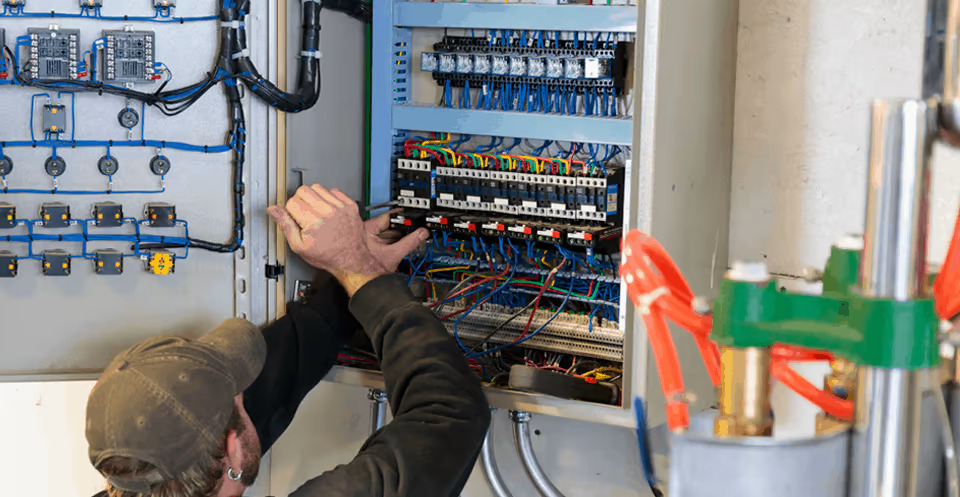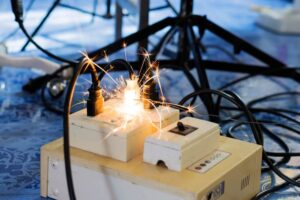Electrical Components and Devices
Switches and Dimmers control the flow of electricity to lights and other devices. Switches turn them on or off, while dimmers allow you to adjust the brightness level.
Outlets are the points in the circuit where electrical devices can be plugged in. Outlets are commonly found on walls, though can be found on other areas of homes and buildings.
Circuit Breakers and Fuses are safety devices that protect the electrical circuit from overloads and short circuits. They automatically interrupt the flow of electricity when necessary to prevent damage or fire.
Junction Boxes are enclosures that house electrical connections and protect them from damage. They are often found in walls or ceilings and are crucial for safety and organization.
Transformers are devices that convert voltage levels to match the specific requirements of electrical devices. They are commonly used for low-voltage lighting systems or to step down voltage from the utility line.
Electrical Wiring
Types of Wiring include Romex, Knob and Tube, and Aluminium. Romex is a common type used in modern homes, while Knob and Tube and Aluminium wiring are found in older homes. Each has its own considerations for safety and maintenance.
Conductors are materials that allow the flow of electrical current. Copper is the most commonly used conductor due to its high conductivity.
Grounding is the process of connecting electrical devices and components to the ground. It provides a safe path for electrical faults, preventing shocks and reducing fire hazards.
Wire Gauge refers to the thickness or diameter of electrical wires. Thicker wires have lower gauge numbers and can carry more current.
Wire Nuts and Connectors are used to securely connect or join wires together. They ensure a reliable electrical connection and prevent loose or exposed wires.
Incandescent Lighting produces light by heating a filament inside a bulb. They are traditional bulbs but are less energy-efficient compared to other options.
Fluorescent Lighting uses a gas and phosphor coating to produce light when an electrical current passes through. They are more energy-efficient than incandescent bulbs and commonly found in offices and commercial spaces.
LED Lighting stands for Light Emitting Diode. They are highly energy-efficient, long-lasting, and available in various colours and brightness levels. LED lighting is becoming increasingly popular in homes.
Lumens measure the brightness of a light source. The higher the lumen value, the brighter the light emitted.
Colour Temperature refers to the appearance of light and is measured in Kelvin (K). Lower values (around 2700K-3000K) provide warm, cosy lighting, while higher values (5000K-6500K) offer cooler, more daylight-like lighting.
Safety Terms and Codes
Ground Fault Circuit Interrupter (GFCI) is a safety device that quickly shuts off power when it detects a ground fault, preventing electric shocks. GFCI outlets are commonly found in areas exposed to moisture, such as bathrooms and kitchens.
Arc Fault Circuit Interrupter (AFCI) is a device that detects dangerous electrical arcs, which can cause fires. AFCIs help prevent electrical fires by shutting off the power when an arc fault is detected.
Australian Standards AS/NZS 3000:2018 Wiring Rules is a set of standards and guidelines for electrical installations. It ensures electrical systems are safe and up to code, providing guidelines for wiring, equipment, and safety practices.
Overload occurs when the electrical circuit is carrying more current than it can handle, leading to overheating and potential damage. It is crucial to avoid overloading circuits by distributing electrical loads evenly.
Short Circuit is an unintended connection between two conductors that bypasses the normal circuit path. It can cause excessive current flow, leading to overheating, damage, or fire.
Energy Efficiency Terms
Energy Star is an international standard for energy-efficient consumer products. It indicates that a product meets strict energy efficiency guidelines, helping homeowners save energy and reduce costs.
Power Factor measures how effectively electrical power is used. A higher power factor means more efficient power usage and reduces energy waste.
Standby Power refers to the energy consumed by devices in standby mode when not in active use. Minimising standby power helps reduce energy waste and lower electricity bills.
Energy Audit is an assessment of a home’s energy usage and efficiency. It identifies areas of improvement, such as insulation, lighting, and appliances, to optimize energy consumption.
Load Management involves managing and balancing electrical loads to optimise energy usage. It may include strategies like shifting heavy energy consumption to off-peak hours to reduce strain on the electrical grid.
Common Electrical Abbreviations
AC/DC stands for Alternating Current/Direct Current. AC is the type of current used in most homes, while DC is commonly used in batteries and electronic devices.
HVAC stands for Heating, Ventilation, and Air Conditioning. It refers to the systems and technologies used for indoor climate control.
DIY stands for Do-It-Yourself. It refers to tasks or projects that individuals can undertake themselves without professional assistance.
AFCI/GFCI abbreviates Arc Fault Circuit Interrupter/Ground Fault Circuit Interrupter, two important safety devices discussed earlier.
kWh stands for kilowatt-hour, a unit of electrical energy consumption. It is commonly used to measure electricity usage on utility bills.











